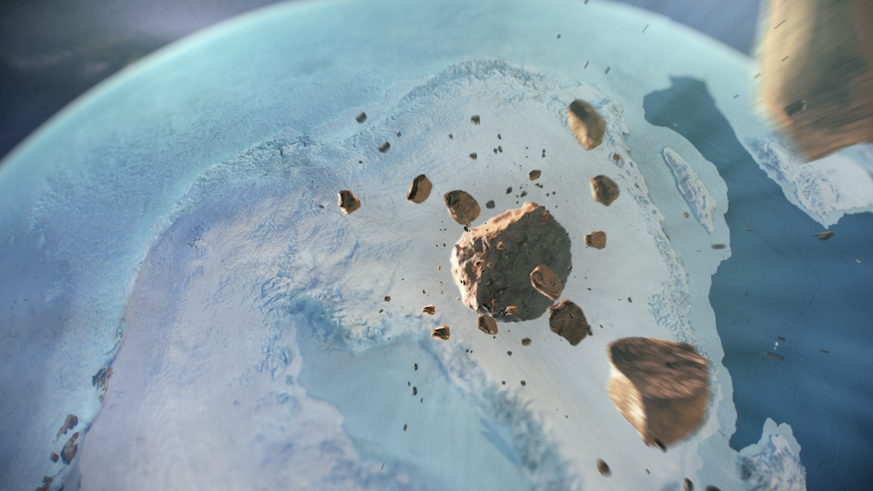Giant meteorite crater found beneath Greenland’s ice sheet
14 November 2018

A giant crater left over from the catastrophic impact of a meteorite crashing into Earth has been uncovered deep below the ice sheets in Greenland.
The 31 km-wide crater, which is bigger than Paris, has been discovered by an international team of scientists who believe it to have been caused by a meteorite impact on Earth between 3 million and 12,000 years ago.
The crater was discovered below the Hiawatha Glacier in northwest Greenland and is the first time ever that an impact crater of any size has been found underneath one of Earth’s continental ice sheets.
Evidence published today in the journal Science Advances suggests the crater was formed when a kilometer-wide iron meteorite smashed into northern Greenland.
Since then the crater has been buried under ice over a kilometer thick, preserving the secrets of a dramatic event that could have drastically altered the climate and led to serious consequences for life on Earth at the time.
The team, which was led by researchers from the Centre for GeoGenetics at the Natural History Museum of Denmark, University of Copenhagen, first discovered the crater in July 2015 when they happened upon a previously undetected ‘circular depression’ under the Hiawatha Glacier whilst inspecting a new map of the topography beneath Greenland’s ice sheet.

Intrigued by this finding, the team piloted a research plane over the glacier to perform state-of-the-art ice radar measurements, which exceeded all expectations and revealed the impact crater in stunning detail.
As a result of detailed chemical analysis performed at Cardiff University, the researchers were able to paint a picture of the type of object capable of causing such monumental destruction by measuring the sediment from a river that drains straight through the glacier.
In particular, the experts looked for signs of platinum, palladium, rhodium and gold, amongst other metals, that would indicate the presence of a meteorite.
“When the results came through from the chemical analysis, they were certainly unexpected,” explained co-author of the research Dr Iain McDonald, from Cardiff University’s School of Earth and Environmental Sciences.

Initially we thought we might find the signature from a chrondritic or ‘stoney’ meteorite but the only explanation for the pattern of metals that we found had to be a mixture between the crustal rocks in the surrounding area and an unusual iron asteroid.
A number of iron meteorites, including a 20-tonne fragment which now sits proudly in the courtyard of the Geological Museum in Copenhagen, had previously been found in the area around Cape York not far from the Hiawatha site in northern Greenland.
This led the scientists to believe that an impact must have occurred in the region, but up until now the team lacked the evidence to support their hypothesis.
“The signature we identified was not exactly the same as the iron meteorite previously found at Cape York; however, iron asteroids represent fragments of metal cores inside planetoids that were catastrophically disrupted by collisions during the early history of the Solar System.
“Chemically, our samples and the iron meteorite are highly heterogeneous and likely represent different fragments bound together by gravity. Fractionated iron meteorites are rare and finding two such occurrences in close proximity may be more than coincidence.
“While it requires more research, we consider it possible that the Cape York irons may have been outer fragments or even boulders on the surface of the main meteorite. We suspect these initially detached in Earth’s gravity field and then decelerated as they entered the atmosphere to fall south of the Hiawatha crater,” continued Dr McDonald.

Lead author of the research Professor Kurt H. Kjær, from the Natural History Museum of Denmark, said: “The crater is exceptionally well-preserved and that is surprising, because glacier ice is an incredibly efficient erosive agent that would have quickly removed traces of the impact.”
“The next step in the investigation will be to confidently date the impact. This will be a challenge because it will probably require recovering material that melted during the impact from the bottom of the structure, but this is crucial if we are to understand how the Hiawatha impact affected life on Earth,” continued Professor Kjær.
Share this story
The School is committed to achieving the highest standards in research and education and to providing a rich and varied research-led environment.


